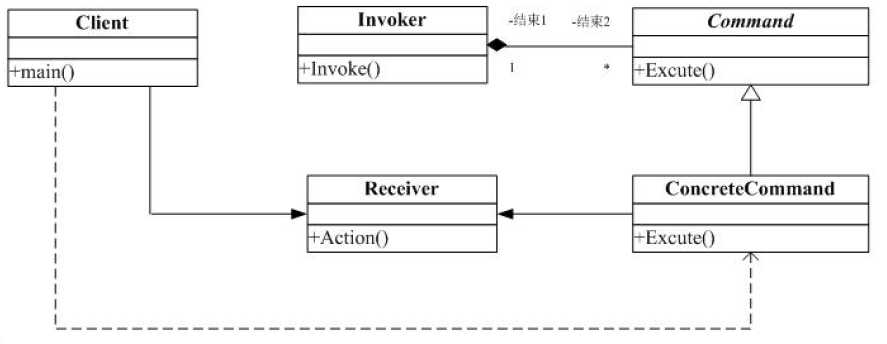标签:
1.Command模式通过将请求封装到一个对象(Command)中,并将请求的接受者存放到具体的ConcreteCommand类中(Receiver)中,从而实现调用操作的对象和操作的具体实现者之间的解耦。
2.Command 模式结构图

3.实现

1 #ifndef _RECEIVER_H_ 2 #define _RECEIVER_H_ 3 4 class Reciever 5 { 6 public: 7 Reciever(); 8 ~Reciever(); 9 void Action(); 10 protected: 11 private: 12 }; 13 14 #endif

1 #include "Receiver.h" 2 #include <iostream> 3 4 Reciever::Reciever() 5 { 6 7 } 8 Reciever::~Reciever() 9 { 10 11 } 12 void Reciever::Action() 13 { 14 std::cout<<"Reciever action......."<<std::endl; 15 }

1 #ifndef _COMMAND_H_ 2 #define _COMMAND_H_ 3 4 class Reciever; 5 6 class Command 7 { 8 public: 9 virtual ~Command(); 10 virtual void Excute() = 0; 11 protected: 12 Command(); 13 private: 14 }; 15 16 class ConcreteCommand:public Command 17 { 18 public: 19 ConcreteCommand(Reciever* rev); 20 ~ConcreteCommand(); 21 void Excute(); 22 protected: 23 private: 24 Reciever* _rev; 25 }; 26 27 #endif

1 #include "Command.h" 2 #include "Receiver.h" 3 #include <iostream> 4 5 Command::Command() 6 { 7 8 } 9 Command::~Command() 10 { 11 12 } 13 void Command::Excute() 14 { 15 16 } 17 ConcreteCommand::ConcreteCommand(Reciever* rev) 18 { 19 this->_rev = rev; 20 } 21 ConcreteCommand::~ConcreteCommand() 22 { 23 delete this->_rev; 24 } 25 void ConcreteCommand::Excute() 26 { 27 _rev->Action(); 28 std::cout<<"ConcreteCommand..."<<std::endl; 29 }

1 #ifndef _INVOKER_H_ 2 #define _INVOKER_H_ 3 4 class Command; 5 6 class Invoker 7 { 8 public: 9 Invoker(Command* cmd); 10 ~Invoker(); 11 void Invoke(); 12 protected: 13 private: 14 Command* _cmd; 15 }; 16 17 #endif

1 #include "Invoker.h" 2 #include "Command.h" 3 #include <iostream> 4 5 Invoker::Invoker(Command* cmd) 6 { 7 _cmd = cmd; 8 } 9 Invoker::~Invoker() 10 { 11 delete _cmd; 12 } 13 void Invoker::Invoke() 14 { 15 _cmd->Excute(); 16 }

1 #include "Command.h" 2 #include "Invoker.h" 3 #include "Receiver.h" 4 #include <iostream> 5 6 using namespace std; 7 8 int main(int argc,char* argv[]) 9 { 10 Reciever* rev = new Reciever(); 11 Command* cmd = new ConcreteCommand(rev); 12 Invoker* inv = new Invoker(cmd); 13 inv->Invoke(); 14 return 0; 15 }
4.将请求接收者的处理抽象出来作为参数传给Command对象,实际也就是回调的机制(Callback)来实现这一点,也就是说将处理操作方法地址(在对象内部)通过参数传递给Command对象(涉及到C++成员函数指针的概念)。简单示例:

1 #ifndef _RECEIVER_H_ 2 #define _RECEIVER_H_ 3 4 class Reciever 5 { 6 public: 7 Reciever(); 8 ~Reciever(); 9 void Action(); 10 protected: 11 private: 12 }; 13 14 #endif

1 #include "Receiver.h" 2 #include <iostream> 3 4 Reciever::Reciever() 5 { 6 7 } 8 Reciever::~Reciever() 9 { 10 11 } 12 void Reciever::Action() 13 { 14 std::cout<<"Reciever action......."<<std::endl; 15 }

1 #ifndef _COMMAND_H_ 2 #define _COMMAND_H_ 3 4 class Command 5 { 6 public: 7 virtual ~Command(){} 8 virtual void Excute() = 0; 9 protected: 10 Command(){} 11 private: 12 }; 13 14 template<class Reciever> 15 class SimpleCommand:public Command 16 { 17 public: 18 typedef void (Reciever::* Action)(); 19 20 SimpleCommand(Reciever* rev,Action act) 21 { 22 _rev = rev; 23 _act = act; 24 } 25 26 virtual void Excute() 27 { 28 (_rev->* _act)(); 29 } 30 31 ~SimpleCommand() 32 { 33 delete _rev; 34 } 35 protected: 36 private: 37 Reciever* _rev; 38 Action _act; 39 }; 40 41 #endif

1 #include "Command.h" 2 #include "Receiver.h" 3 #include <iostream> 4 using namespace std; 5 6 int main(int arc,char* argv[]) 7 { 8 Reciever* rev = new Reciever(); 9 Command* cmd = new SimpleCommand<Reciever>(rev,&Reciever::Action); 10 cmd->Excute(); 11 return 0; 12 }
标签:
原文地址:http://www.cnblogs.com/programmer-wfq/p/4671142.html